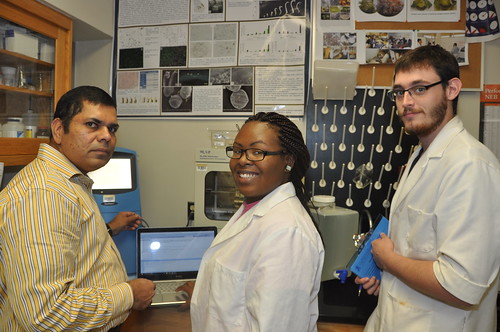
This post is part of the Science Tuesday feature series on the USDA blog. Check back each week as we showcase stories and news from USDA’s rich science and research portfolio.
At Fort Valley State University (FVSU) the next generation of leaders in agricultural and life sciences are coming face-to-face with technology that will help them solve the toughest challenges of the future.
“Bioinformatics is ‘biology in silico,’ or ‘digital biology,’ and it is transforming biological research into an informational science,” said Dr. Ramana Gosukonda, associate professor of agricultural sciences at FVSU’s College of Agriculture.
Gosukonda and his team created a bioinformatics curriculum at FVSU where students majoring in STEM (science, technology, engineering, and mathematics) subjects join with computer science majors to become competent bioinformatics programmers and gain hands-on experiences in writing algorithms and coding for biological problems. USDA’s National Institute of Food and Agriculture (NIFA) is supporting the project with a $150,000 grant from its 1890 Capacity Building program.
Bioinformatics practitioners – bioinformaticians – use computers to store, organize, and analyze the vast amounts of data generated by scientific research. In other words, they take big data and turn it into practical data that researchers can use to compare existing information with new data. The capacity, speed, efficiency, and accuracy of bioinformatics are what make biology in silico so exciting for Gosukonda.
“Application of bioinformatics is key to our understanding of diseases and identifying new molecular targets for drug discovery, gene therapy, and economic production of healthy food items,” he said.
Many bioinformatics projects involve examining the genetic diversity of wild plants and animals. In one such NIFA-funded project researchers at the University of Minnesota used a $459,000 Agriculture and Food Research Initiative grant to develop bioinformatics software tools and then used them to study the biodiversity of wild pandas. This type of research could inform conservation and reintroduction efforts for other endangered species.
“Being strongly intertwined with computer-based approaches, the current state of research underscores the need for bioinformatics education more than ever,” Gosukonda said. “This curriculum must be offered at the undergraduate level, especially at four-year colleges, where a majority of the students pursue their education.”
Since the grant’s award in September 2015, Gosukonda has created hands-on programming modules and case studies for two bioinformatics courses to enhance students’ knowledge and skills in the subject. The bioinformatics lab is nearing completion and will be stocked with powerful workstations and state-of-the-art education delivery systems. So far, 20 undergraduate and 30 graduate students are enrolled.
Students aren’t the only ones that benefit from Gosukona’s program, the university does, too. “The immediate effect is greatly enhanced teaching, research, and educational state-of-the-art technology infrastructure,” he said. “Further, a value-added program like bioinformatics will help FVSU in its efforts to increase the recruitment, retention and graduation rates of minority students.”
NIFA invests in and advances agricultural research, education and extension and seeks to make transformative discoveries that solve societal challenges.
This month USDA is celebrating historic progress over the last eight years to improve the quality of life and access to opportunity for all Americans. Learn more online in The People's Department: A New Era for Civil Rights at USDA.
